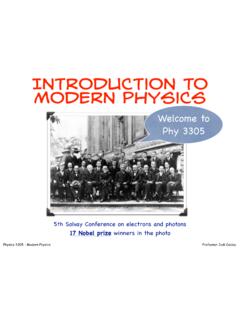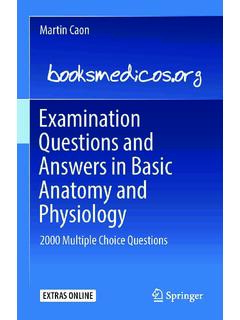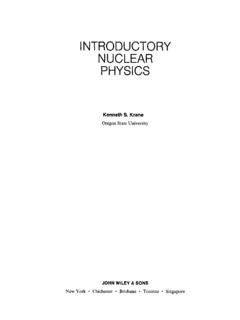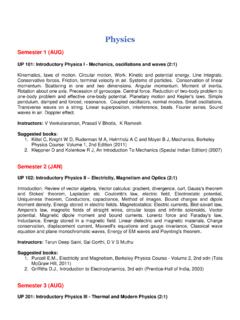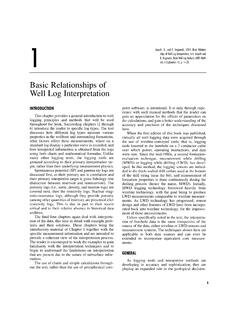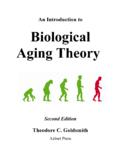Transcription of Modern Physics - AHEPL
1 Modern PhysicsThird EditionRAYMOND A. SERWAYE meritusJames Madison UniversityCLEMENT J. MOSESE meritusUtica College of Syracuse UniversityCURT A. MOYERU niversity of North Carolina-WilmingtonAustralia Canada Mexico Singapore SpainUnited Kingdom United StatesCopyright 2005 Thomson Learning, Inc. All Rights Reserved. Physics Editor: Chris HallDevelopment Editor: Jay CampbellEditor-in-Chief: Michelle JuletPublisher: David HarrisEditorial Assistant: Seth DobrinTechnology Project Manager: Sam SubityMarketing Manager: Kelley McAllisterMarketing Assistant: Leyla JowzaAdvertising Project Manager: Stacey PurvianceProject Manager, Editorial Production: Teri HydePrint/Media Buyer: Barbara BrittonPermissions Editor: Sarah HarkraderProduction Service: Progressive Publishing AlternativesText Designer: Patrick DevineBrooks/Cole Thomson Learning10 Davis DriveBelmont, CA 94002 USAAsiaThomson Learning5 Shenton Way #01-01 UIC BuildingSingapore 068808 Australia/New ZealandThomson Learning102 Dodds StreetSouthbank, Victoria 3006 AustraliaCanadaNelson1120 Birchmount RoadToronto, Ontario M1K 5G4 CanadaEurope/Middle East/AfricaThomson LearningHigh Holborn House50/51 Bedford RowLondon WC1R 4 LRUnited KingdomLatin AmericaThomson LearningSeneca, 53 Colonia Polanco11560 Mexico , 2528015 Madrid, SpainFor more information about our products, contact us at:Thomson Learning Academic Resource Center1-800-423-0563 For permission to use material from this text or product, submit a request online at additional questions about permissions can be submitted by email to Director: Rob HugelPhoto Researcher: Dena Digilio-BetzCopy Editor: Progressive Publishing AlternativesIllustrator: Rolin Graphics/Progressive InformationTechnologiesCover Designer: Patrick DevineCover Image.
2 Patrice Loiez, CERN/Science PhotoLibrary, Artificially colored bubble chamber photofrom CERN, the European particle Physics laboratoryoutside Geneva (1984).Cover Printer: Coral Graphic ServicesCompositor: Progressive Information TechnologiesPrinter: Quebecor World, TauntonCOPYRIGHT 2005, 1997, 1989 by Raymond A. RIGHTS RESERVED. No part of this work covered bythe copyright hereon may be reproduced or used in anyform or by any means graphic, electronic, or mechanical,including but not limited to photocopying, recording, tap-ing, Web distribution, information networks, or informa-tion storage and retrieval systems without the written per-mission of the in the United States of America1 2 3 4 5 6 7 08 07 06 05 04 Library of Congress Control Number: 2004101232 Student s Edition: ISBN 0-534-49339-4 International Student Edition: ISBN 0-534-40624-6 Copyright 2005 Thomson Learning, Inc. All Rights Reserved. Raymond A. Serwayreceived his doctorate at Illinois Institute of Technology andis Professor Emeritus at James Madison University.
3 Dr. Serway began his teachingcareer at Clarkson University, where he conducted research and taught from1967 to 1980. His second academic appointment was at James Madison Univer-sity as Professor of Physics and Head of the Physics Department from 1980 to1986. He remained at James Madison University until his retirement in 1997. Hewas the recipient of the Madison Scholar Award at James Madison University in1990, the Distinguished Teaching Award at Clarkson University in 1977, and theAlumni Achievement Award from Utica College in 1985. As Guest Scientist at theIBM Research Laboratory in Zurich, Switzerland, he worked with K. Alex M ller,1987 Nobel Prize recipient. Dr. Serway also held research appointments at RomeAir Development center from 1961 to 1963, at IIT Research Institute from 1963to 1967, and as a visiting scientist at Argonne National Laboratory, where he col-laborated with his mentor and friend, Sam Marshall. In addition to earlier edi-tions of this textbook, Dr. Serway is the co-author of Physics for Scientists and Engi-neers,6th edition, Principles of Physics ,3rd edition, College Physics ,6th edition, andthe high-school textbook Physics ,published by Holt, Rinehart, and Winston.
4 Inaddition, Dr. Serway has published more than 40 research papers in the field ofcondensed matter Physics and has given more than 60 presentations at profes-sional meetings. Dr. Serway and his wife Elizabeth enjoy traveling, golfing, fish-ing, and spending quality time with their four children and seven J. Mosesis Emeritus Professor of Physics at Utica College. He wasborn and brought up in Utica, New York, and holds an from HamiltonCollege, an from Cornell University, and a from State University ofNew York at Binghamton. He has over 30 years of science writing and teachingexperience at the college level, and is a co-author of College Physics , 6th edition,with Serway and Faughn. His research work, both in industrial and universitysettings, has dealt with defects in solids, solar cells, and the dynamics of atomsat surfaces. In addition to science writing, Dr. Moses enjoys reading novels,gardening, cooking, singing, and going to A. Moyerhas been Professor and Chair of the Department of Physics andPhysical Oceanography at the University of North Carolina-Wilmington since1999.
5 Before his appointment to UNC-Wilmington, he taught in the PhysicsDepartment at Clarkson University from 1974 to 1999. Dr. Moyer earned a Lehigh University and a from the State University of New York atStony Brook. He has published more than 45 research articles in the fields ofcondensed matter Physics and surface science. In addition to being an experi-enced teacher, Dr. Moyer is an advocate for the uses of computers in educa-tion and developed the Web-based QMToolssoftware that accompanies thistext. He and his wife, V. Sue, enjoy traveling and the special times they spendwith their four children and three the AuthorsiiiCopyright 2005 Thomson Learning, Inc. All Rights Reserved. This book is intended as a Modern Physics text for science majors and engi-neering students who have already completed an introductory calculus-basedphysics course. The contents of this text may be subdivided into two broad cat-egories: an introduction to the theories of relativity, quantum and statisticalphysics (Chapters 1 through 10) and applications of elementary quantum the-ory to molecular, solid-state, nuclear, and particle Physics (Chapters 11through 16).
6 OBJECTIVESOur basic objectives in this book are threefold:1. To provide simple, clear, and mathematically uncomplicated explana-tions of physical concepts and theories of Modern To clarify and show support for these theories through a broad range ofcurrent applications and examples. In this regard, we have attempted toanswer questions such as: What holds molecules together? How do elec-trons tunnel through barriers? How do electrons move through solids?How can currents persist indefinitely in superconductors?3. To enliven and humanize the text with brief sketches of the historical de-velopment of 20th century Physics , including anecdotes and quotationsfrom the key figures as well as interesting photographs of noted scientistsand original material covered in this book is concerned with fundamentaltopics in Modern Physics with extensive applications in science and engineer-ing. Chapters 1 and 2 present an introduction to the special theory of relativ-ity.
7 Chapter 2 also contains an introduction to general relativity. Chapters 3through 5 present an historical and conceptual introduction to early develop-ments in quantum theory, including a discussion of key experiments that showthe quantum aspects of nature. Chapters 6 through 9 are an introduction tothe real nuts and bolts of quantum mechanics, covering the Schr dingerequation, tunneling phenomena, the hydrogen atom, and multielectronPrefaceivCopyright 2005 Thomson Learning, Inc. All Rights Reserved. atoms, while Chapter 10 contains an introduction to statistical Physics . The re-mainder of the book consists mainly of applications of the theory set forth inearlier chapters to more specialized areas of Modern Physics . In particular,Chapter 11 discusses the Physics of molecules, while Chapter 12 is an introduc-tion to the Physics of solids and electronic devices. Chapters 13 and 14 covernuclear Physics , methods of obtaining energy from nuclear reactions,and medical and other applications of nuclear processes.
8 Chapter 15 treatselementary particle Physics , and Chapter 16 (available online at )covers TO THE THIRD EDITIONThe third edition contains two major changes from the second edition: First,this edition has been extensively rewritten in order to clarify difficult concepts,aid understanding, and bring the text up to date with rapidly developing tech-nical applications of quantum Physics . Artwork and the order of presentationof certain topics have been revised to help in this process. (Many new photosof physicists have been added to the text, and a new collection of color pho-tographs of Modern Physics phenomena is also available on the Book Com-panion Web Site.) Typically, each chapter contains new worked examples andfive new end-of-chapter questions and problems. Finally, the Suggestions for Fur-ther Readinghave been revised as ,this edition refers the reader to a new, online (platform indepen-dent) simulation package, QMTools,developed by one of the authors, CurtMoyer.
9 We think these simulations clarify, enliven, and complement the analyt-ical solutions presented in the text. Icons in the text highlight the problemsdesigned for use with this software, which provides modeling tools to help stu-dents visualize abstract concepts. All instructions about the general use of thesoftware as well as specific instructions for each problem are contained on theBook Companion Web Site, thereby minimizing interruptions to the logicalflow of the text. The Book Companion Web Site at contains appendices and much supplemental information on cur-rent Physics research and applications, allowing interested readers to digdeeper into many changes by chapter in this third edition are as follows: Chapter 1 in the previous editions, Relativity, has been extensively revisedand divided into two chapters. The new Chapter 1,entitled Relativity I, contains the history of relativity, new derivations of the Lorentz coordinateand velocity transformations, and a new section on spacetime and causality.
10 Chapter 2,entitled Relativity II, covers relativistic dynamics and energyand includes new material on general relativity, gravitational radiation,and the applications GPS (Global Positioning System) and LIGO (theLaser Interferometer Gravitational-wave Observatory). Chapter 3has been streamlined with a more concise treatment of theRayleigh-Jeans and Planck blackbody laws. Material necessary for a com-plete derivation of these results has been placed on our Book CompanionWeb Site. Chapter 5contains a new section on the invention and principles of op-eration of transmission and scanning electron 2005 Thomson Learning, Inc. All Rights Reserved. Chapter 6, Quantum Mechanics in One Dimension, features a newapplication on the principles of operation and utility of CCDs (Charge-Coupled Devices). Chapter 8, Quantum Mechanics in Three Dimensions, includes a newdiscussion on the production and spectroscopic study of anti-hydrogen, astudy which has important consequences for several fundamental physicalquestions.
